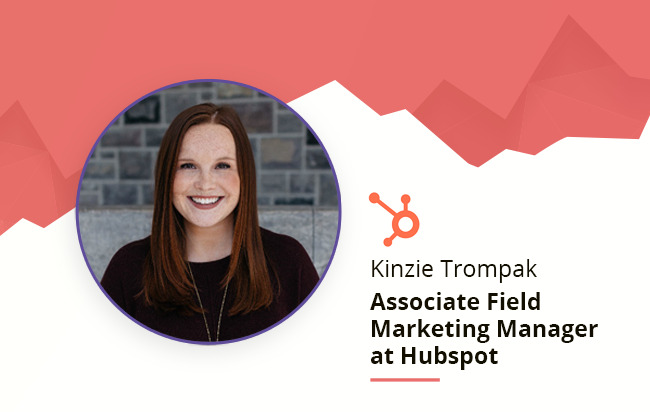
Kinzie Trompak may be young, but this associate field marketing manager for HubSpot sounds like an experienced digital marketer when she talks about aligning sales and marketing (also known as RevOps). Speaking at a Research Triangle HubSpot User Group, Kinzie shared some best practices to leverage HubSpot during lead generation activities.
Traditional marketers view their activities as a funnel, where a customer is simply the outcome of a number of marketing activities. However, HubSpot views the entire customer engagement as a “flywheel” which spins continuously and uses the momentum of satisfied customers to drive referrals and repeat sales.
In a flywheel model, the division between sales and marketing is blurred. Smarketing, or the alignment between sales and marketing teams, means that both sales and marketing teams have customer touchpoints throughout the customer journey.
HubSpot’s lead scoring system makes it easy for both teams to recognize who should be leading the engagement, a position that changes during the customer lifetime. For example, in the early stages, a customer would primarily interact with marketing and then start to engage sales as they are ready to make a purchase. Following the sale, however, marketing can step back in, delivering content designed to encourage repeat sales, upsells, and cross-sells.
Lead Scoring
According to Kinzie, lead scoring is a complementary piece to marketing automation. Essentially, it calculates when a prospect is “sales-ready,” by attaching a score to different activities. Once a prospect’s score has reached a predefined threshold, they are considered marketing qualified leads (MQL), and sales starts to move into the picture.
There are a number of different ways for leads to generate scores. Demographic data, such as job title, company size, company revenue and location, are different pieces of demographic data that you can score.
Behavior provides additional attributes. You can assign scores for attending webinars, downloading assets from landing pages, or reading blogs.
There are some demographics and behaviors that indicate a low-quality lead. Students, job applicants, or bad job titles are red flags that can bring on a negative lead score.
The demographic, behavioral, and negative data are tabulated in HubSpot. Users who reach a predefined score attain MQL status and start to get more attention from the sales team.
Calculating a Score
Different activities and characteristics have different values for a sales team. Define the critical, essential and influential attributes for demographic and behavioral characteristics. For example, a VP is a better prospect than a Manager, so the VP would fall into the “Critical” category and be worth more points than a manager, who falls into the “Important” category.
Similarly, downloading a free trial or clicking on an RFP indicates that the prospect is closer to buying than someone who watches a webinar or reads a blog. Higher-value activities score more points.
Meanwhile, if someone indicates they are a student, visits the careers page, or unsubscribes to your email, it indicates they aren’t really a lead, and they should be assessed a negative score.
Benefits of Lead Scoring
Lead scoring impacts marketing efforts in significant ways. For starters, it identifies leads who need more nurturing. When used in tandem with marketing automation, leads at different scoring levels automatically receive different types of marketing collateral. If they engage in that collateral, they’ll increase their score and move closer to MQL status.
Second, lead scoring maximizes the efficiency of the sales team, who can stop wasting their time on prospects who aren’t going anywhere. Instead, they can focus their efforts on the leads that are sales-ready.
From Kinzie’s perspective, this means sales teams reduce the number of low-quality leads who aren’t ready to buy.
Tips to Get Started
Kinzie offered five tips to start lead scoring.
- Start with What You Already Know – Even if you haven’t scored leads in the past, you know what it takes for leads to turn into prospects. Make a list of your recent sales successes and identify the steps they took to move from lead to MQL to sales success. As you notice more and more similarities between the customer journeys, you’ll be able to identify important milestones your customers need to cross.
- Start with 0-100 scale – You can use any numbers you want in building your scale, but it’s easy to process a scale that goes to 100.
- Capture Better Data – Your scoring is only as good as the data it is built on. If needed, upgrade your ability to identify and track user behavior.
- Don’t Overcomplicate Things – Like most things in life, keep it simple. Make your scoring system simple to understand. Don’t create sliding scales for the quality of interactions with content. Create a system that is intuitive and easy to use.
- Use Excel to Map it Out – Map out your Critical, Important, and Influencer categories, as well as your negative scores. Apply points to each activity based on your past customer experiences. For example, if leads historically need to see 10 pieces of content before becoming MQLs, you need to weigh each piece of content appropriately so that they reach 100 points after seeing the content.
Do You Need Lead Scoring?
If your sales team has enough great leads, you can probably live without lead scoring. However, if your sales team isn’t getting enough leads or they are constantly complaining about the number of bad leads they have to wade through, lead scoring can help them improve the quality of their leads.
Kinzie does caution that for lead scoring to work; marketing teams need to produce enough content for their leads and have a system in place to track all the data.
Trying to coordinate your sales and marketing teams. Contact Penguin Strategies to schedule your Marketing/Sales Alignment Workshop.

by The Penguin Team on December 05, 2022
As a leading B2B digital marketing agency, We help B2B Technology Companies, enterprise software, and hardware companies increase brand awareness, reach more qualified leads and close more customers. Penguin Strategies is a Diamond Partner of HubSpot.





